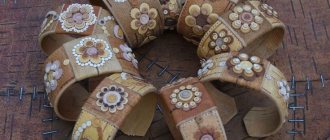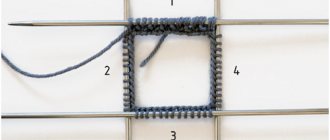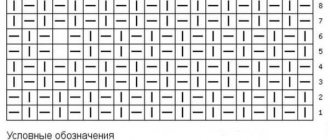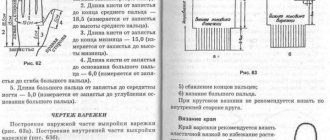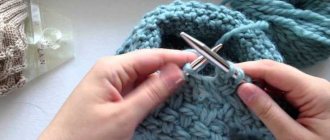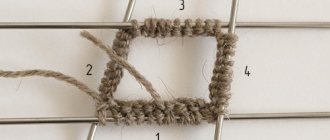Materials and tools for knitting potholders
Since the purpose of a potholder is not only aesthetic beauty, but also to protect your hands from burns, the choice of materials for its manufacture should be approached in a special way.
Important! Under no circumstances choose yarn made from viscose and silk. They will not prevent burns.
Cotton, acrylic and wool are best suited for these purposes. But they cannot be combined so as not to lose the shape of the product during operation.
When choosing thick yarn, you should avoid any thickening in its structure, since making patterns with such a thread will make it impossible to use it when working with hot surfaces.
Crocheting potholders: patterns and descriptions
Flower
By choosing floral elements and experimenting with color schemes in their design, you can always create a unique item that harmoniously matches the kitchen interior. Choose no more than two contrasting colors.
Additional Information! In order to maintain the shape and color of the product, only periodic washing in cool water is enough. Afterwards you should starch and iron it.
- The center should start with a dark color, closing 8 air loops in a ring.
- The second row consists of 18 st. S.N.
- In the third, 1 stitch of the second row is knitted and another loop of 23 chain stitches is connected. Having connected further 1 st.b.n. you get 9 additional loops with 1 same stitch between them.
- The next two rows are tied with the resulting loops. The top of each loop is added with three single crochets.
- The sixth and seventh ones change color, but maintain the previous order of operation.
- In the 10th I count 7 st.
bn to wrap them into a petal and connect them to the eighth. You can knit a potholder either with knitting needles or with crochet. It all depends on the type of ornament and the thickness of the yarn.
Spiral
The essence of making such a potholder is that several colors are used in a single circular row. The difficulty of such weaving is only that while one color is used, the remaining loops remain open.
Important! To prevent loose loops from tangling and unraveling, you should secure them with a marker that can block them. These “markers” can be pins or paper clips.
To make a potholder you will need 5 colors of cotton yarn, 100 g each, 4 markers and a No. 4 hook. The diameter of the finished product will be 21 cm.
Let's accept the designations for colors in advance:
A – red;
B – brick;
B – orange;
G – yellow;
D – beige.
First, we make an inner ring from the darkest color - 1 chain stitch, 1 tbsp. b.n., 1 p.s.n., 2 tbsp. S.N. Having attached a new thread, we repeat the process again with each subsequent color.
In the first row we perform 2 tbsp for each color. S.N. from one loop and 1 tbsp. S.N. into the next loop.
In the second we use the same number of loops, but repeat three times. Then everything is simple - only the second art. changes. S.N. – another +1 is added to it. We do this for seven rows, the last of which will already have 2 tbsp. s n. from one loop and 6 tbsp. S.N. in the next stitch three times for each color.
In the eighth, in the sequence of colors D, D, C, B, A, we make 3 stitches for rounding. S.N. and 3 tbsp. b.n., combining which you can cut the thread.
The product is ready after we also knit the back part and fasten them to the front part using color D.
Do-it-yourself knitted items help create a special coziness.
Hexagon
This potholder is similar to homemade cookies. In its manufacture, only double crochets and air loops are used.
Knitted according to a very simple pattern.
Bees
“Bees” in the kitchen can delight children who like to watch or help their parents in the cooking process.
Mischievous bees will greatly delight small children.
To make it you will need black, yellow and white cotton yarn - 50 grams of each. For the eyes, nose and mouth, it is worth purchasing mercerized threads in black, white and red colors. Hooks No. 1.5 - for threads and 3.5 - for cotton.
This potholder should be knitted in accordance with the pattern.
The main pattern is carried out according to the scheme, taking into account that the decrease at the beginning of the row consists of skipping, and at the end by simply not knitting it.
Sunflower
The diagram of this product is very similar to the diagram of the Flower potholder.
A very beautiful and easy to make potholder.
The same steps are followed, starting with a flat circle. Then 12 petals are knitted, tied with three rows of single crochets and continue according to the pattern.
Potholder pattern “Flower”.
Lamb
This potholder will consist of several parts at once, which will have to be knitted in stages.
Each lamb is knitted separately.
The main part is knitted in the form of a circle, according to the pattern. The last row should be taken in a darker shade.
Sheep body diagram.
Next we knit a very simple forelock, also knitting the fabric with yarn of a darker shade
Diagram of a sheep's forelock.
To make the legs, we collect white threads into 9 chain stitches and make 3 lifting loops. In the fifth loop we first knit one, then 3 double crochets, 2 half-double crochets, 1 tbsp. b.n., 3 tbsp. S.N. in one loop, 1 tbsp. b.n., 2 half-columns, 4 tbsp. S.N. and 3 air loops - close in the initial loop.
For the ears, use dark-colored yarn to cast on 8 air loops and close them into a ring. In the second loop add 1 double crochet, 1 double crochet and dc. b.n., 1 half-column and 3 half-columns in one loop.
We make ears and legs in pairs.
Peacock
For the first row of the base, you need to cast on 2-3 air loops and close them in a circle.
First we take beige threads.
In the second we make 7 half-columns. In the 3rd, 4th and 5th rows we make 17, 37 and 50 double crochets, respectively.
We supplement the finished part with any contrasting thread, knitting a row with single crochets. But it is important to leave 8 loops intact. (16)
We tie it with black contrasting thread.
Using double crochets we knit the tail. 4-5 rows are knitted with “fans” - no more, increasing the number of “fans” in each of them. (17)
Next we introduce an orange thread. And after 3 rows - burgundy.
Using contrasting thread again, we also tie the tail. (18)
Using black thread we knit the feathers on the peacock's tail.
Don't forget to make a loop on the middle fan. (19)
The loop is needed to hang the potholder next to the stove.
We knit the body in single crochet columns. At the end, you need to pull the last thread so that the body rises towards the tail.
We knit the body in a dark color.
Next we sew on the eye, embroider the beak, tie up the legs and sew the head to the body. (20-21)
Here is such a handsome peacock made from leftover yarn.
heart
This pot holder will be a nice Valentine's Day gift for your mom, sister or friend.
An original potholder, knitted very quickly.
Square potholders
A regular square potholder is very easy to knit. You can make it original by experimenting with color combinations or adding small knitted flowers to the front part.
The potholder in white and lilac color looks very nice.
Potholder Sunflower video master class
This video is about how to crochet a napkin. But if you make a loop from air loops, the napkin will turn into a potholder.
Ladybug master class for beginners
The Ladybug potholder for the kitchen looks very funny. It only takes 1-2 hours to make it yourself.
You will need:
- black yarn and one more of your choice;
- hook corresponding to the thickness of the thread.
Description
Connect a chain of VP and close.
Knitting pattern 1 p. – 6 sc in the ring, SS. 2 r. – 2 RLS in 1 p., SS. 3 r. – 2 RLS in 1 p., 1 RLS, SS. 4 rub. – 2 RLS in 1 p., 2 RLS, SS. 5 rub. – 2 RLS in 1 p., 3 RLS, SS. 6 rub. – 2 RLS in 1 p., 4 RLS, SS.
We continue in the same spirit until we obtain the desired diameter. Next, use a black thread to sew a “back needle” stitch in the middle of the circle.
Now we knit the head. We start knitting from the edge of the circle. We knit 8 sc, turning over, we knit another 8 sc. Turn it over again and knit 6 sc, making one decrease on each side, turn it over and make 2 more decreases along the edges. The thread was secured.
Now we make the binding and loop. We start on the opposite side of the ladybug's head. We tie the sc in a circle, and, having knitted in a circle, we make a loop of 10-15 VP. Knit six spots, each of which has three circular rows (based on the principle of knitting the base of a potholder). Sew on circles and make eyes from either beads or white yarn. The Ladybug potholder is ready!
Source
Knitting potholders
Knitting needles are chosen in the same way as a hook - in accordance with the width of the thread. The number of the knitting needle will be its size.
You can also knit patterns or ornaments using knitting needles, but it is better to start with the simplest knitting technique - multi-colored stripes.
Knitting for beginners
Additional information and tips:
- Alternating knit and purl stitches allows you to achieve a three-dimensional pattern.
- A secret technique for beginning craftsmen is embroidery. If you can’t knit a beautiful ornament with knitting needles, then you can resort to embroidery on top of an already knitted surface.
- A little secret for determining the size of the knitting needles: lightly twist the threads in half - the ideal thickness of the knitting needles is the thickness of the twisted threads.
Beginners should start with simple checkered or striped patterns.
To make a simple two-color potholder, you need to cast on 11 loops and knit 20 rows of each color, alternately with the front and back sides. (25, 26)
Potholders in the form of multi-colored squares.
Knitted potholder in a circle
In the form of an orange
For such a potholder you need 50 grams of cotton yarn in white and yellow or orange colors and a 4.5 mm knitting needle.
After each row, the knitting needles must be turned over. All loops are facial:
1st row - knit 14 loops, leaving the 15th out of work;
Knit the 2nd and all subsequent rows from the wrong side with facial loops;
3, 5, 7, 9, 11 rows – decrease by 2 loops each time;
13th and 14th - knit all 15 loops.
The last 14 rows must be repeated 10 more times, and then duplicate rows 1-13. Use white thread to bind off all stitches in the purl row.
Potholders knitted in short rows.
Potholder with a leaf, knitted from the center
This potholder is very easy to knit.
The color of the yarn can be completely different.
Potholders with shadow patterns
This pattern is created by moving the front stitch to the back and back. (29-31)
This potholder is very easy to knit according to the pattern.
Enterlac technique
This method of knitting will allow you to create a product similar to patchwork.
Row 1 – knit 21 stitches with the wrong side.
2nd – turn the knitting every two loops, alternating purl and knit stitches.
3rd - in each inner row we add one loop until we get the first triangle.
The product will consist of such triangles.
Simply amazing oven mitts are made if you knit them using the enterlac technique.
Potholders with shadow patterns
Kitchen items with the so-called shadow pattern look very interesting.
By matching it to the color palette of your kitchen or home, you can get a very harmonious design. In addition, the same potholders can be made using a simple hosiery method by changing the color of the yarn to create a pattern.


